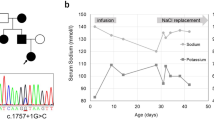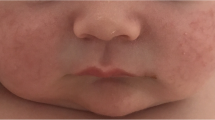Abstract
Pseudohypoaldosteronism Type II (PHAII) is a very rare disorder characterized by hyperkalemia, hypertension, and slight hyper-chloremic metabolic acidosis. The index patient showed typical features of PHAII, including elevated blood pressure (140–150/90–100 mmHg), hyperkalemia in the range of 5.30–5.60 mmol/l (normal range is 3.50–5.10 mmol/l), accompanied by hyperchloremia of 109.5–112.0 mmol/l (normal 95.0–108.0 mmol/l) and acidosis with bicarbonate levels of 19.5–20.1 mmol/l (normal 22.0–27.0), GFR was 98.95 ml/min (normal > 90). However, these features were absent in his parents. Sequencing analysis found the patient with a WNK4 gene mutation, 1682 C > T in Exon 7, which resulted a missense mutation at codon 561 (P561L). The variation in codon 561 was not found in his parents and 100 unrelated control subjects. The identified WNK4 mutation which has not been described previously is the probable cause of PHAII.

Similar content being viewed by others
References
H. Mayan, I. Vered, M. Mouallem et al., J. Clin. Endocrinol. Metab. 87, 3248–3254 (2002)
W.K.A. Paver, G.J. Pauline, Med. J. Aust. 2, 305–306 (1964)
Z. Farfel, A. Iaina, T. Rosenthal et al., Arch. Intern. Med. 138, 1828–1832 (1978)
Z. Farfel, A. Iaina, J. Levi et al., Arch. Intern. Med. 138, 1837–1840 (1978)
M. Schambelan, A. Sebastian, F.C. Rector Jr., Kidney Int. 19, 716–727 (1981)
R.D. Gordon, Hypertension 8, 93–102 (1986)
T.A. Mansfield, D.B. Simon, Z. Farfel et al., Nat. Genet. 16, 202–205 (1997)
S. Disse-Nicodeme, J.M. Achard, I. Desitter et al., Am. J. Hum. Genet. 67, 302–310 (2000)
F. Wilson, S. Disse-Nicodeme, K. Choate et al., Science 293, 1107–1112 (2001)
A.P. Golbang, M. Murthy, A. Hamad et al., Hypertension 46, 295–300 (2005)
F.H. Wilson, K.T. Kahle, E. Sabath et al., Proc. Natl. Acad. Sci. USA. 100, 680–684 (2003)
K.T. Kahle, F.H. Wilson, Q. Leng et al., Nat. Genet. 35, 372–376 (2003)
A.M. Ring, S.X. Cheng, Q. Leng et al., Proc. Natl. Acad. Sci. USA. 104, 4020–4024 (2007)
K.T. Kahle, G.G. MacGregor, F.H. Wilson et al., Proc. Natl. Acad. Sci. USA. 101, 14877–14882 (2004)
G. Gamba, Am. J. Physiol. Renal Physiol. 288, F245–F252 (2005)
H. Mayan, G. Munter, M. Shaharabany et al., J. Clin. Endocr. Metab. 89, 4025–4030 (2004)
Acknowledgments
We thank the patient and his family members for their participation in this study. We are also grateful to Libin Liu (Department of endocrinology and metabolism, Union Hospital affiliated to Fujian Medical University, Fujian, China) for collecting samples from the patient’s family. This study was supported by the grant from Shanghai Leading Academic Discipline Project (project number: Y0204).
Author information
Authors and Affiliations
Corresponding author
Rights and permissions
About this article
Cite this article
Gong, H., Tang, Z., Yang, Y. et al. A patient with pseudohypoaldosteronism type II caused by a novel mutation in WNK4 gene. Endocr 33, 230–234 (2008). https://doi.org/10.1007/s12020-008-9084-8
Received:
Accepted:
Published:
Issue Date:
DOI: https://doi.org/10.1007/s12020-008-9084-8




